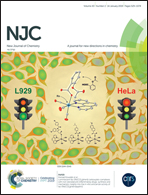Single-step fluorescence recognition of As3+, Nd3+ and Br− using pyrene-linked calix[4]arene: application to real samples, computational modelling and paper-based device†
Abstract
A new fluorescence sensor, namely, TDPC, which is composed of a pyrene group connected to calix[4]arene as the fluorogenic unit, has been synthesized, characterized and analyzed with regard to its selective sensing ability for As3+ (0–150 nM), Nd3+ and Br− (0–120 nM), with detection limits of 11.53 nM, 0.65 nM and 11.25 nM, respectively. The binding constant (Ks) was found to be 7.842 × 108 M−1 for As3+, 6.877 × 108 M−1 for Nd3+ and 6.311 × 108 M−1 for Br−. Furthermore, we report an easy-to-use, low-cost and disposable paper-based sensing device for rapid chemical screening of As3+, Nd3+ and Br−. The device comprises a luminescent sensing probe embedded in a cellulose matrix in which resonance energy transfer seems to be the sensing mechanism. It opens up new opportunities for simple and fast screening in remote settings where sophisticated instrumentation is not always available. The MOPAC2016 software package was used to optimize TDPC using the well-established PM7 method, and the HOMO–LUMO energy band gap was calculated for TDPC and TDPC with structures based on As3+, Nd3+ and Br− ions. To determine the influence of different metal ions on TDPC, a molecular docking study was carried out using HEX software. Furthermore, to assess its analytical applicability, the prepared sensor was successfully used for the analysis of two different real samples (an industrial soil sample for Nd3+ and industrial waste water for As3+ and Br−) to validate the proposed method, with recoveries of ions of 95–99%.
![Graphical abstract: Single-step fluorescence recognition of As3+, Nd3+ and Br− using pyrene-linked calix[4]arene: application to real samples, computational modelling and paper-based device](/en/Image/Get?imageInfo.ImageType=GA&imageInfo.ImageIdentifier.ManuscriptID=C8NJ03506G&imageInfo.ImageIdentifier.Year=2019)


 Please wait while we load your content...
Please wait while we load your content...